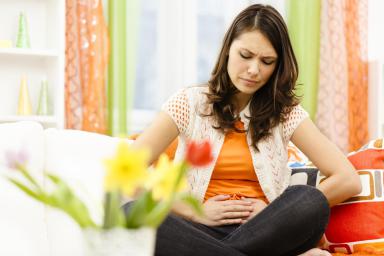 It’s that time of the month again, ladies, and you know you’re going to feel crampy and bloated for a few days. But some women have to experience severe dysmenorrhea or painful menstruation. Dysmenorrhea is literally translated as "difficult monthly flow" and often causes the sufferers severe pain each time their menstrual period comes around. In fact, the American College of Obstetricians and Gynecologists (ACOG) reports that about 1 in 10 women experience such severe menstrual pain that they cannot keep up their normal schedule for 1 to 3 days each month. The pain is so intense that nausea and vomiting, diarrhea and all over aches and pains may happen. Now let's get a close look and find out dysmenorrhea cures that really work.
It’s that time of the month again, ladies, and you know you’re going to feel crampy and bloated for a few days. But some women have to experience severe dysmenorrhea or painful menstruation. Dysmenorrhea is literally translated as "difficult monthly flow" and often causes the sufferers severe pain each time their menstrual period comes around. In fact, the American College of Obstetricians and Gynecologists (ACOG) reports that about 1 in 10 women experience such severe menstrual pain that they cannot keep up their normal schedule for 1 to 3 days each month. The pain is so intense that nausea and vomiting, diarrhea and all over aches and pains may happen. Now let's get a close look and find out dysmenorrhea cures that really work.
Two Types of Dysmenorrhea
There are two types of dysmenorrhea: primary and secondary.
Primary dysmenorrhea is not related to any underlying gynecological problem but associated with the menstrual process itself. It is believed to be caused by an overabundance of prostaglandins, the hormones that promote uterine contractions when menstruating and during childbirth.
This type of dysmenorrhea usually begins in adolescence and the pain often lessens as a woman ages, particularly after childbirth. Although it can be debilitating at times, it is not considered harmful. Factors that may make primary dysmenorrhea even more problematic include stress, a retroverted uterus (one that tips backwards instead of forwards), beginning to menstruate before age 11, smoking, drinking alcohol, being overweight or lacking exercise.
Secondary dysmenorrhea is more likely to affect adult women and is usually connected to some type of gynecological condition. Those conditions could include:
- Endometriosis
- Fibroid tumors
- Sexually transmitted infection
- The endometrium (tissue that lines the uterus) grows within the uterine walls, a condition known as adenomyosis
- Using an IUD for birth control
- PID (pelvic inflammatory disease)
- Ovarian cyst or tumor
Women with secondary dysmenorrhea often suffer more severe menstrual pain than those with primary dysmenorrhea and may even feel pain at times when they are not menstruating or during intercourse. Those who have secondary dysmenorrhea feel pain earlier than others and may last longer. The symptoms include pain in the lower abdomen but may be felt in the lower back, thighs or hips as well. You may also feel lightheaded, nauseous, experience vomiting or have diarrhea along with general body aches and pains.
Dysmenorrhea Treatments
Normally, the menstruation pain is not harmful and will abate on its own. But if it affects your daily life or persist for a long time, treatments are necessary.
Traditional Dysmenorrhea Treatments
The first step is to see your healthcare provider to try and pinpoint any underlying problems which may be triggering the pain and causing secondary dysmenorrhea. Primary dysmenorrhea is usually treated with medications such as anti-inflammatory drugs and analgesics. Sometimes oral contraceptives are prescribed as well.
If the condition hasn’t improved after 3 months treatments, secondary dysmenorrhea is suspected. Treatments for secondary dysmenorrhea vary according to the underlying gynecological problem creating the pain and can range from hormone treatments to surgery.
Alternative Dysmenorrhea Treatments
Some alternative dysmenorrhea cures that have seen some success in treating dysmenorrhea include acupuncture, hypnotism or acupressure. Many other women find some relief by:
- Taking a hot bath.
- Applying a heating pad to the lower back or abdomen.
- Doing light exercises such as stretching, biking, or walking. Exercise might improve the blood flow and relieve pain.
- Gently massaging the abdomen.
- Resting and avoiding stress.
- Having an orgasm.
- Practicing yoga.
Aromatherapy is another helpful treatment. Choose an essential oil such as chamomile, clary sage, or rosemary, and combine a few drops of it with a carrier oil such as coconut oil, olive oil, or almond oil. Massage this mixture on your abdomen or soak a cloth in the mixture and lay it on your belly.
There are some herbal remedies such as crampbark, fennel, chamomile, and beet root that many women say relieve painful menstrual cramps. A cup of raspberry or other herbal tea with a teaspoon of ginger can be a soothing remedy. Please keep in mind, however, that although herbs are natural, some do have side effects or may interact with other medications you are taking. Please discuss with your doctor before using them.
Dietary Dysmenorrhea Treatment
Sometimes a change in dietary habits may help ease the pain of dysmenorrhea. Magnesium deficiency is considered a leading cause of menstrual pain, so having magnesium rich diet including nuts, green leafy vegetables and whole grains is important. Alternatively, you can take a magnesium supplement.
Omega fatty acids also rank high for its function of reducing menstrual pain. These essential fatty acids can be found in fishes such as mackerel, salmon, anchovies and sardines. Fish oil in capsules also provides relief.
Vitamin E and vitamin B1 (thiamine) are also recommended supplements. Besides, eliminating caffeine and alcohol intake, eating less red meat and egg yolks, and adding more fresh vegetables and fruits into your diet will help lessen the pain of dysmenorrhea.